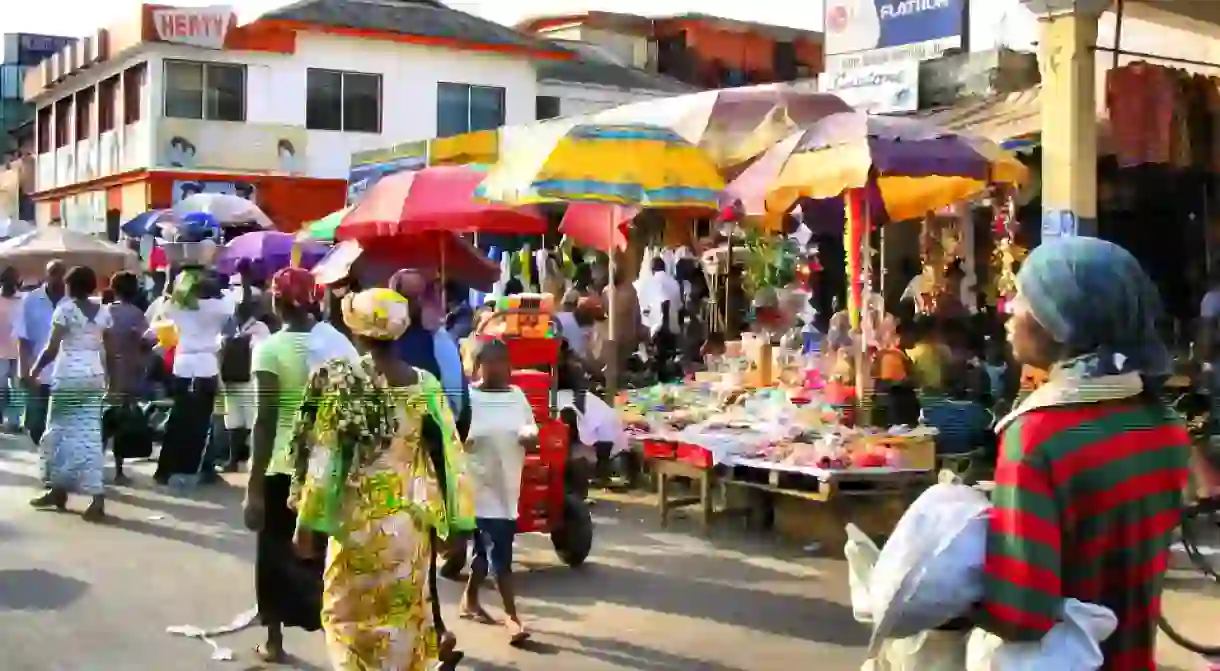A Guide to Accra's Kantamanto Market

Kantamanto is Ghana’s biggest second hand clothes market and it’s right in the heart of the capital, Accra; annexed to Makola Market; the largest point of trade in the city. Kantamanto is a community on its own – full of arrangements of hand-me-down clothes, vehicle spare parts, home decor and footwear, which together give it the look of a grand flea market with almost no space left to spare.
The market’s structure
This bustling centre of commerce was gutted by a fire in 2013, but is now back to its former glory. At the centre of Accra, Kantamanto is marked out to the south by the popular White Chapel (UTC) building and to the north by a train line which connects Dzorwulu to Tema. Sheds the size of typical Ghanaian lotto booths with no doorways stack previously owned suits, t-shirts, jeans, dresses, lingerie, flip flops and khaki trousers, in what looks like a giant series of collages.
At weekends, there’s more human traffic than on weekdays as people from Accra and its outskirts flood the market, bargaining their way through the wooden stalls and magically meandering through the labyrinth of stacked clothes. Buyers visit from as far as the Eastern, Volta, Central regions and even from neighbouring countries, to update their stock.

Accessibility and potential
The sale of imported packages of second hand clothes, usually given for donation in Europe and Asia, has shaped the economy in Kantamanto and its neighbourhood for about four decades and counting. The over 30,000 traders who mount stands and such like in the market every day have contributed immensely to the grassroots economy of the country. Another factor in its continued popularity is its central location.

Activity, codes and the catch
Sometimes bells ring out and at other times whole choruses are improvised to attract buyers. Throngs of shoppers comb through clothes on hangers and shoes dangling by their laces. The less attractive products usually find their way onto the floor, in heaps that are known locally as ‘bend-down boutique’. Market activity starts very early in the morning, so latecomers get the floor offerings and other left overs.
Locals call second hand clothes ‘broni we wu’ meaning ‘the white person has died’, as that seems the most likely reason for their belongings being put back on the market.

Peak times & tips
Wednesday and Saturday are the busiest days, as that’s when new stock comes in. Ghanaian market women and their culture make for an entertaining experience. There’s been much recent debate about the scales of distribution and the ethics of trading in used clothes, leading to the ban of second hand underwear in 2010. Currently there’s a pronounced Chinese involvement in the textile, shoemaking and phone trade, which has affected the growth of local manufacturing industries.

Après-haggling
Take a break from the overloaded hustle and grab a bite of yam and kontomire stew, banku and okra soup or fufu and groundnut dish from the indigenous food stalls at Rawlings Park. Vegans are also catered for, and right in the middle of the park, you can sample wagashi, tatali, soya khebabs, red-red or bofloat. The Accra Art Centre, National Theatre and Kwame Nkrumah Mausoleum – the last resting place of the first President of Ghana – are all within a kilometre (0.62 miles) distance from Kantamanto. There are always friendly and welcoming people available to take you around or help with directions so you don’t necessarily need a professional guide.













